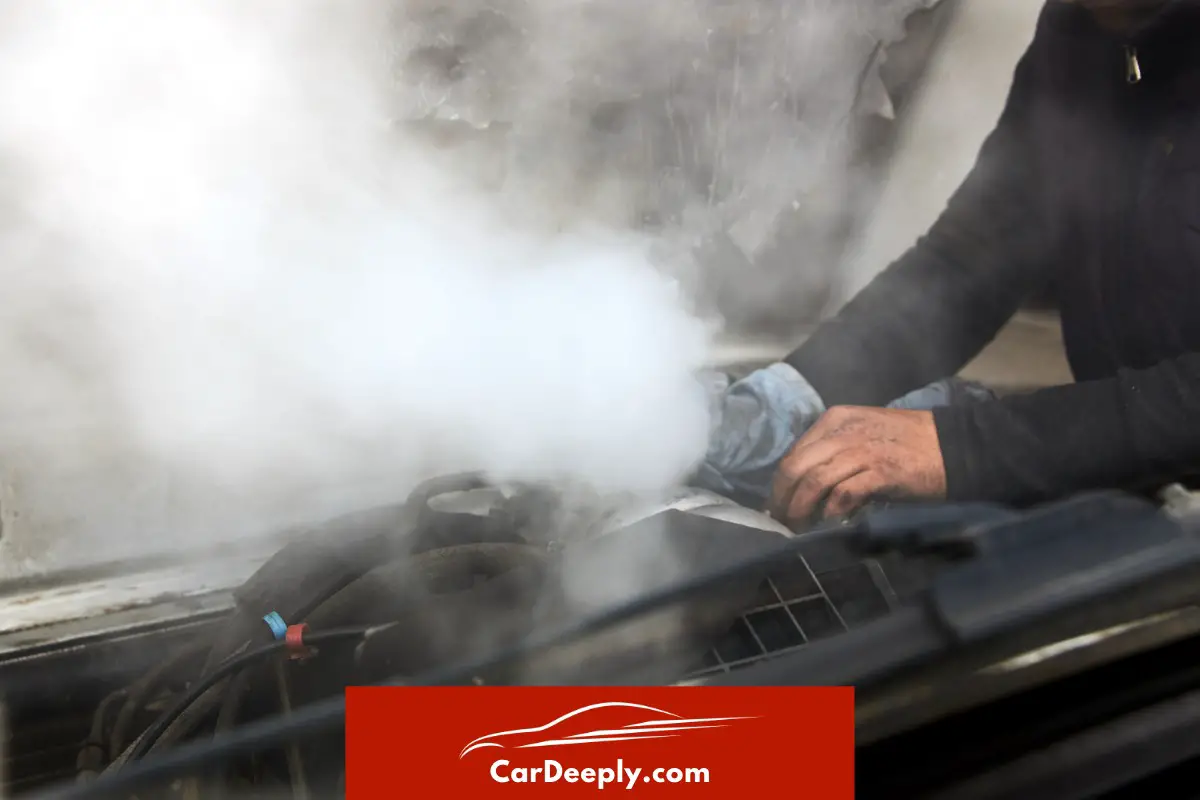Running with a hot engine is a terrible idea – even something as sturdy as a RAV4 won’t last long before it leads to a fatal accident.
So, to keep you safe on the road, we’ve compiled the best fixes to help.
In this article, you’ll find details on these fixes and tips to prevent your car from overheating again.
Advertising links are marked with *. We receive a small commission on sales, nothing changes for you.
Overheating Signs In a RAV4

You can’t know that the car is overheating by feel very easily, but the below symptoms are a dead giveaway:
- Dashboard warning lights turning on, such as the check engine light or AWD system malfunction light.
- Steam or smoke coming from under the hood.
- Speedometer reading higher or lower than normal.
- Vacuum leaks.
- Strange noises coming from the engine.
- A strong odor of coolant.
Reasons Why Your Toyota RAV4 May Be Overheating
Diagnosing overheating problems in your Toyota RAV4 can be tricky, but here are some common reasons:
- Coolant Leak: Low coolant levels from a leak in the radiator, hoses, water pump, or engine can be a common but hard to notice culprit behind Toyota RAV4 overheating.
- Thermostat Failure: The thermostat acts as a coolant traffic cop, but when it fails, the engine can overheat due to poor circulation.
- Radiator Fan Malfunction: When the radiator fan goes on the fritz, it stops blowing cool air through the system, leaving the coolant hot and the engine in danger of overheating.
- Clogged Radiator: A dirty and debris-clogged radiator can strangle coolant flow, causing the engine to overheat and risk serious damage.
- AWD System Malfunction: RAV4 hybrid models may overheat when the AWD system overworks itself, consuming too much energy and leaving the engine at risk.
- Fuel Tank Or Fuel Injection Issues: A malfunctioning fuel system can cause the engine to overheat from the strain of trying to meet fuel demands.
What Not to Do When Your RAV4 Overheats?
If your Toyota RAV4 starts overheating while you’re driving, it can be a worrisome experience.
It’s important to know what to do in such a situation but equally important to know what not to do.
Here are some things you should avoid doing when your RAV4 overheats:
- Do not continue driving if you notice that your RAV4 is overheating.
- Do not remove the radiator cap when the engine is hot.
- Do not pour cold water into the radiator.
- Do not drive without coolant.
- Do not ignore the problem if your RAV4 is overheating.
RAV4 Overheating: What Fixes To Try out?
If your RAV4 is overheating, your cooling system may be the culprit. The cooling system keeps your engine temperature in check, and a failure can lead to serious engine damage. Don’t fret, though; try out these fixes to get your car back on the road in no time:
Fix 1: Refill or Replace Coolant
Check your coolant level and condition – this liquid circulates through the radiator, hoses, water pump, and thermostat to cool the engine. Ensure it’s at the correct level and has a green or orange color.
If not, add or change the coolant as soon as possible to avoid poor heat transfer and corrosion in the cooling system.
Fix 2: Clean or Repair Radiator and Fan
Inspect your radiator and fan – the radiator dissipates heat from the coolant, and the fan blows air through it. Ensure they’re clean, undamaged, and working correctly.
If the radiator is clogged or damaged, or if the fan is broken or not spinning, clean, repair, or replace them to avoid reduced cooling efficiency and airflow.
Fix 3: Test and Replace Thermostat and Water Pump
Test your thermostat and water pump – the thermostat regulates the flow of coolant, while the water pump pumps coolant through the cooling system. Ensure they’re functioning correctly and not stuck or leaking.
If the thermostat is stuck closed or the water pump is worn or leaking, they can cause overheating.
Fix 4: Replace Damaged Hoses
Look at all the hoses in your cooling system for leaks, cracks, or blockages. If you find any damage or debris, it can reduce coolant flow and cause overheating.
Replace damaged hoses and clean out blockages to restore proper coolant flow.
Fix 5: Check for Coolant Contamination in Engine Oil
Inspect your engine oil for signs of coolant contamination, such as a milky appearance or a sweet smell. This can indicate a head gasket leak, which can cause overheating.
If you suspect coolant contamination, have your engine checked by a professional mechanic.
Fix 6: Clean or Replace Air Filter
Clean or replace your air filter to ensure proper airflow to the engine. A dirty or clogged air filter can reduce airflow and cause overheating.
Check your owner’s manual for the recommended air filter replacement interval and follow it accordingly.
Fix 7: Verify Temperature Gauge or Warning Light
Verify that your temperature gauge or warning light is functioning properly. If your gauge reads hot or your warning light comes on, it could indicate an overheating problem.
Have your cooling system checked by a professional mechanic if you notice any issues with the temperature gauge or warning light.
Fix 8: Check for Other Signs of Engine Damage
Check for any other signs of engine malfunction or damage that may be contributing to the overheating issue.
Look for unusual noises, smells, or performance issues such as reduced power or acceleration. If you notice any of these symptoms, have your engine checked by a professional mechanic to avoid any additional problems.
Breakdown of Cost for Repairing An Overheating Toyota RAV4
The cost of repairing an overheating Toyota RAV4 can vary depending on the damage’s cause and extent. Here are some estimated costs:
- Coolant Leak Repair: $150-$800
- Thermostat Replacement: $150-$300
- Radiator Fan Replacement: $300-$700
- Water Pump Replacement: $500-$1000
- Engine Damage Repair: $1000-$2000+
Do note that these costs may vary depending on your location, the condition of your vehicle, and the quality of the parts and labor.
Tips for Preventing Overheating Issues in a RAV4
Want to avoid dealing with such an issue again? Here are some quick and effective tips to help:
- Schedule regular servicing and maintenance, including coolant flushes and oil changes.
- Check your vehicle’s coolant levels and condition regularly.
- Inspect hoses, belts, and the radiator for damage or wear and replace them if necessary.
- Replace the air filter on a regular basis to ensure proper airflow to the engine.
- Monitor your dashboard warning lights and address any issues promptly.
FAQs
How often should I change the engine coolant on my Toyota RAV4?
Toyota recommends changing the engine coolant on a Toyota RAV4 every 100,000 miles or every 5 years, whichever comes first.
How long can a car overheat before damage?
It only takes a few minutes of engine overheating to cause serious engine damage.
Is it OK to drive a car after it overheats?
It’s not recommended to drive a car after it overheats, as it can cause further damage to the engine. It’s best to have the car towed to a mechanic for repairs.
Final Thoughts
Toyota’s cars are reliable and durable, but even the best cars can experience overheating problems.
Now that you know how to diagnose and fix an overheating RAV4, you won’t have to deal with such problems. You can truly enjoy a safer and smoother driving experience.
Just make sure to keep these tips in mind to get the optimal performance.

Sebastian loves convertibles and drove a BMW 335i for a long time (325 hp is just a dream). Today, with two children, he is more concerned with SUVs and family-friendly vehicles. In addition to an Audi A4 Avant, he also drives a Cupra Formentor VZ – even as a family man, you can’t do without speed. Get to know Sebastian better and visit the About Us page.
Advertising links are marked with *. We receive a small commission on sales, nothing changes for you.
